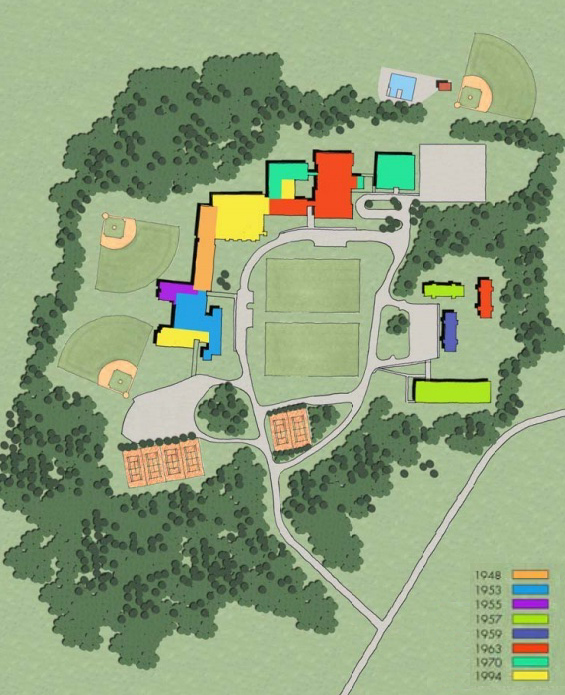
A summary of “value engineering” items trimmed to bring the school project back to the approved $93.9 budget (click to enlarge).
Town officials provided updates on the two pending school campus construction projects at the State of the Town meeting on October 20, outlining a series of cuts made to bring the school project under budget and a timeline for the community center.
The detailed construction cost estimate presented to the School Building Committee in September was about $9 million more than the $93.9 million budget approved by voters in June, so the SBC had just weeks to decide what to trim as it prepares for bonding votes at a Special Town Meeting on December 1 and at the ballot box on December 3. The areas where cost estimates rose the most compared to the figures presented in June were site work, which went up by $5.22 million, and temporary modular classrooms, which rose by $2.94 million.
After three weeks of painstakingly combing through a list of more than 100 construction items, the SBC got the project under budget. Members actually trimmed more than $9 million because they also added two items: $870,000 for an upgraded HVAC system and $150,000 for a slightly redesigned center of the building.
The biggest savings will come from site work. The SBC lopped $3.9 million from that category by cutting back on granite curbs and repaving and foregoing new plantings, sod for the ballfield, and new playground equipment. Officials expect to save $1.68 million by negotiating less expensive temporary classrooms.
To save another $2.5 million, the town will hire a third-party firm to install the solar equipment rather than paying for and owning it as part of the project. Lincoln would then enter into a power purchase agreement where it would buy electricity, thus shifting much of the financial burden from the construction budget to the operating budget. On the bright side, this also means that enough solar equipment can be installed to make the school “net zero” in terms of energy use.
The final borrowing amount that the town will vote on in December hasn’t been determined yet, because other sources of funding have to be nailed down. Those sources include the following (with current balances in parentheses):
- The debt stabilization fund ($5.5 million). This fund has been accumulating for years in anticipation of the school project, though the Finance Committee may recommend retaining some of it for the Community Center project
- Free cash (about $1 million). This is a relatively large amount because the town recently received a large building permit fee.
- Community Preservation Act funds (about $600,000 not otherwise designated). These funds can be used to outdoor recreational things like athletic fields and playgrounds.
- The cable revolving fund ($226,000) from the annual license fee to support local cable access. This fund balance increases by about $80,000 a year and Town Administrator Tim Higgins will recommend that the Board of Selectmen “commit the lion’s share of that money” to applicable parts of the school project such as audiovisual work in the Brooks auditorium, he said at an October 18 multiboard meeting.
The town considered using Chapter 90 state funds for roadway improvements to Ballfield Road as part of the school project but decided it would be unwise to divert that money from regular road maintenance around town.
- Click here for the State of the Town presentations by the School Building Committee and Finance Committee
The precise tax impacts of the borrowing won’t be known until the final borrowing amount and bond interest rate are known. “It’ll be less than the 20 percent people had in their minds due to the tranching, but it won’t be a lot less,” Finance Committee chair Jim Hutchinson said. “Tranching” means splitting up the borrowing into two or more loans over a period of time rather than borrowing the full amount in a single loan. Earlier FinCom figures indicated tax increases of 19 to 21 percent. The median tax bill in fiscal 2018 was $13,566.
The town also expects to borrow roughly another $20 million in 2024 to build the community center, which will bring the town’s debt service levels back up to 2019 levels. The most recent estimates for that project range from $15.3 million to $16.2 million depending on which design is selected.
”The school project is the biggest need for the town,” Selectman James Dwyer said at the State of the Town meeting, adding that work on the community center will not begin until the school is “substantially complete.” However, a community center building committee could be formed as soon as 2021, he said. There has been talk of forming a “Friends of…” group to solicit private donations for one or both campus projects, but this hasn’t yet moved beyond the discussion phase.
There will be two community workshops on the project on Thursday, November 1 at 8 a.m. and 7 p.m. in the Reed Gym. Officials have until November 17 to nail down a final bonding amount for the December 1 and December 3 votes. If approved, architects will require about 12 months to complete detailed drawings before the start of construction, which is expected to take up to three years in two phases.







